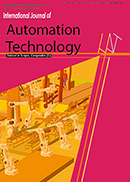Volume 17, Issue 1
Displaying 1-10 of 10 articles from this issue
- |<
- <
- 1
- >
- >|
Special Issue on Advanced Abrasive Processing Technologies
-
Article type: Editorial
2023Volume 17Issue 1 Pages 3-4
Published: January 05, 2023
Released on J-STAGE: January 05, 2023
Download PDF (235K) -
Article type: Research Paper
2023Volume 17Issue 1 Pages 5-13
Published: January 05, 2023
Released on J-STAGE: January 05, 2023
Download PDF (4942K) -
Article type: Research Paper
2023Volume 17Issue 1 Pages 14-20
Published: January 05, 2023
Released on J-STAGE: January 05, 2023
Download PDF (3848K) -
Article type: Research Paper
2023Volume 17Issue 1 Pages 21-31
Published: January 05, 2023
Released on J-STAGE: January 05, 2023
Download PDF (1590K) -
Article type: Research Paper
2023Volume 17Issue 1 Pages 32-39
Published: January 05, 2023
Released on J-STAGE: January 05, 2023
Download PDF (4066K) -
Article type: Research Paper
2023Volume 17Issue 1 Pages 40-46
Published: January 05, 2023
Released on J-STAGE: January 05, 2023
Download PDF (1711K) -
Article type: Research Paper
2023Volume 17Issue 1 Pages 47-54
Published: January 05, 2023
Released on J-STAGE: January 05, 2023
Download PDF (2883K) -
Article type: Research Paper
2023Volume 17Issue 1 Pages 55-63
Published: January 05, 2023
Released on J-STAGE: January 05, 2023
Download PDF (1642K)
Regular Papers
-
Article type: Research Paper
2023Volume 17Issue 1 Pages 65-70
Published: January 05, 2023
Released on J-STAGE: January 05, 2023
Download PDF (1073K) -
Article type: Research Paper
2023Volume 17Issue 1 Pages 71-80
Published: January 05, 2023
Released on J-STAGE: January 05, 2023
Download PDF (883K)
- |<
- <
- 1
- >
- >|
